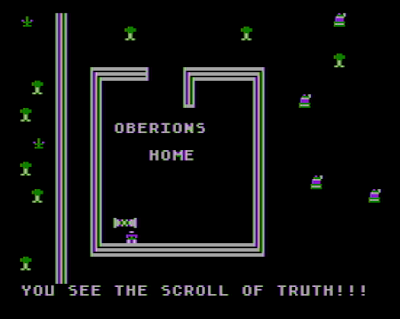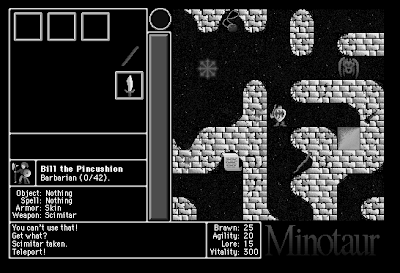From The CRPG Addict
 |
| Problem #1: Nothing Arthur or Galahad did was done “for power.” |
Quest for Power
United States
Crystalware (developer and original publisher); Epyx (later publisher)
Released in 1981 for Atari 800 and Apple II. Rereleased in 1982 as King Arthur’s Heir
Date Started: 5 March 2019
Date Finished: 5 March 2019
Total Hours: 1
Difficulty: Very Easy (1/5)
Final Rating: (to come later)
Ranking at time of posting: (to come later)
Quest for Power is another insulting game from Crystalware, a company that was either knowingly scamming its customers or so clueless about what made a good game that they must have never played one. I admit that their titles at least sound interesting–I was sucked in by the backstory of House of Usher (1980), for instance–but if anything they’ve gotten progressively worse as time passed, losing core elements that made them, if not “good,” at least memorable. A commenter named Tronix recently posted some background on the company, and while we can’t take an anonymous Internet comment as gospel, what he says makes sense given the quality of the games. I’m particularly disturbed about the party where they “skipped town” while still owing money to a lot of developers. I hope the developer of this game, Marc Benioff, managed to recover.
There isn’t much to say about Quest for Power. Like the other Benioff/Crystalware collaboration, The Forgotten Island (1981), it’s a short adventure with a few light RPG elements, recalling in structure the old Adventure for the Atari 2600 (1979). It takes about as long to play and win the game as to read the manual, and the lengths that Epyx went through to puff up the manual for the re-release (as King Arthur’s Heir) are particularly absurd given the paucity of actual gameplay.
 |
| You have to have several artifacts before you enter Canterbury. |
The backstory casts you as Sir Galahad, son of Arthur’s “good friend” Lancelot, who Arthur designates as his heir to the English throne if he can find and return the Scroll of Truth, which Merlin has hidden somewhere on the island. Good lord, that sentence alone manages to mangle the Arthurian legends in about a dozen different ways. The whole point of Galahad’s story–in the few sources where he actually appears–is that he’s too pure for the mortal world, and he is taken bodily into heaven at the end of the Grail Quest. Arthur and Lancelot are hardly “friends” by the end of Arthur’s reign; Merlin should be long gone; and the realm wouldn’t be known as “England” for over 400 years.
 |
| There are several places to buy necessities. This particular list makes it look like I’m about to murder someone and then dump the body off-shore. |
Your little icon sets out from Camelot to explore the land, which I guess is roughly shaped like Britain except that for some reason it’s surrounded by a wall. Your journey will take you to the Caves of Somerset, Hastings Mountain, Sunderland, Essex, the Castle of Skenfrith, the Black Forest, the Eagle Stone, Canterbury, Hillsborough by the Sea, and Leeds. (Of these, only Canterbury has any authentic Arthurian history. “Hastings Mountain” doesn’t even exist.) The manual makes it sound like these are all exotic and interesting places to explore, but really they’re just names written across the screen with maybe one NPC and a treasure item.
 |
| This would have made World War II a lot easier. |
To win the game, you have to defeat a series of enemies (The Devil of Skenfrith Castle, the Black Wizard, Gogmagog–none of them appear in actual Arthuriana) and acquire a series of treasures. For instance, you explore the Caves of Somerset to find the key to Essex, where you find Moses’s Rod (where’s Kenny when you need him?), and so forth. The enemies named in those parentheses, plus a couple of dragons, are the only fights in the game.
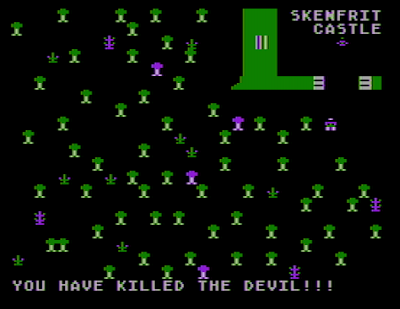 |
| Canonically, Galahad could probably do this. |
Combat is a matter of random rolls. Each round, each fighter does 1-9 points of base damage against the enemy but each round, one of the two combatants gets 10 added to his roll. For instance, you might take 7 damage while doing 19 in the first round, but in the second the Black Wizard gets the bonus and does 15 damage to you versus your 3 damage to him.
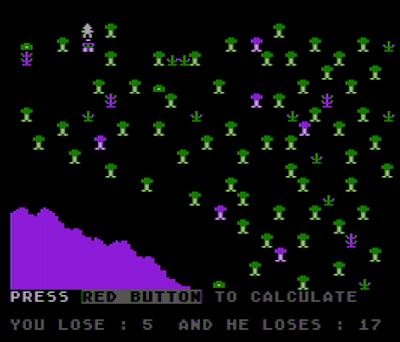 |
| Looks like I got lucky this round. |
As you start off with only 3 hit points, the first combat–whoever you fight it with–is a risk. But if you can win, you’ll gain enough power and extra hit points that further combats become much easier. After your second or third combat, you’re basically invincible.
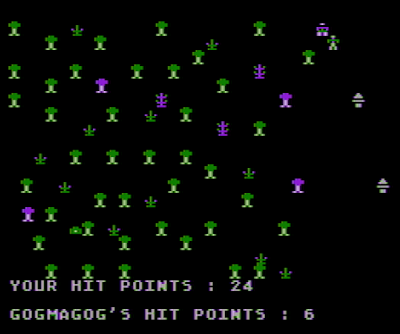 |
| In battle against Gogmagog. |
Gold chests pop up randomly as you explore, and there are a few places where you can spend your gold on an axe, a rope, and a boat. There are three NPCs (Ambrosius, Amadas, and some random guy in Essex Castle) who give you spectacularly unnecessary hints, and one of them must be bribed over 1,000 gold for his.
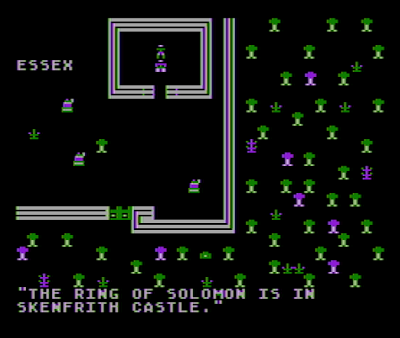 |
| I’m sure I would have found it on my own anyway. |
Once you’ve found enough artifacts and have built up enough power from killing enemies, the guard Oberion (facepalm) will let you into Canterbury. There, you find the Ark of the Covenant. If you open it without the three major artifacts (Anselm’s Staff, Solomon’s Ring, and Moses’s Rod), you’ll be melted in the manner of the Nazis in Raiders of the Lost Ark. With the three artifacts, you find the Scroll of Truth.
Granted, I had the emulator speed cranked up to 250%, but it still only took me about 20 minutes to run around the map and do what I needed to do. The game minimizes its control scheme; the manual actually brags about this. All action is mapped to the joystick except for the (T)rade command. If you have certain items (torch, boat, rope), you’re assumed to use them when the situation calls for it.
Returning the Scroll of Truth to Camelot wins the game. You get a picture of the throne room at Camelot and your score is displayed.
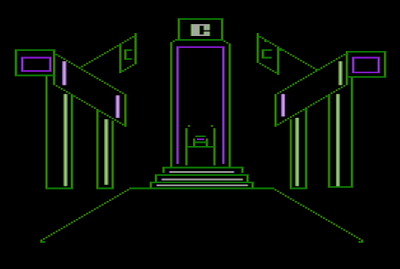 |
| You can tell it’s Camelot by the “C” on the banners. |
But of course it doesn’t end there. As with half of Crystalware’s titles, there’s supposedly a Great Mystery lurking beneath the surface, with players encouraged to solve it and send their solutions to the company, with promises of a $250 cash prize. (The Epyx re-release removes any mention of such a puzzle.) As usual, I not only didn’t solve it, I don’t even know what they’re talking about. Is it something you’re supposed to find in the game? A hidden message? Is it simply winning the game?
 |
| Can anyone identify the source of the image Crystalware used? Reverse image searches were no help. |
The manual says that to solve the mystery, you must a) read the entire manual, b) “go to each of the magical places and talk to all of the magical people.” “It is then,” the manual says, “you may understand the very neurotic mystery.” Did the author not know what “neurotic” means, or is that a clue?
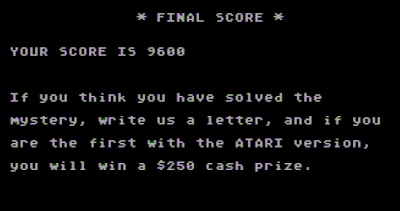 |
| I wonder if they paid anyone. |
The only three people to talk with in the game are Ambrosius, Amadas, and the guy at Essex. Amadas, at Hastings Mountain, says that “you must have Solomon’s Ring and Anselm’s Staff and Gogmagog to make it past Oberion!” (Once you defeat Gogmagog, his power “fuses” with you or something.) Ambrosius is hanging out by something called the Eagle Stone, and he says, “Ah, son of Arthur [???], the staff is in the caves.” Essex says, “The Ring of Solomon is in the Skenfrith Castle.” I’ve looked for anagrams, initialisms, and other wordplay and can’t find anything. Thus, I’ll give a reward of $50 to whoever can solve the mystery, which is five times the value of the GIMLET I gave to Quest for Power. It’s the first game so far with 1s straight across the board.
*****
Let’s talk about how we got so far down the list:
1. I’m having trouble with Planet’s Edge (1991). The introductory application starts up okay, but every time I hit ESC to move on, DOSBox crashes with a “corrupt MCB chain” error. I’ve tried multiple versions. I’ve tried running INSTALL and configuring video and sound different ways. I’ve tried running it with LOADFIX. I have not tried another computer with a different configuration of DOSBox, which I will next week after I move.
2. Minotaur: Labyrinths of Crete (1992) turns out to be a two-player game. (You’re supposed to connect over AppleTalk.) There’s a “single-player mode,” but it just lets you explore the dungeon, pick up items, and test them, not play in any meaningful way. It moves to the rejection list.
3. I thought I had a working copy of OrbQuest from reader Lance M., but I lost it or never downloaded it or something. I had to ask him for it again. He came through, but I had already half-drafted this entry by then. It’ll be soon.
4. I’m moving this week, so I didn’t have time to approach a game as complicated as Ultima VII.
Anyway, this means I need two more games to add to the “upcoming” list, replacing both Quest for Power and Minotaur. The earliest game on my list that I haven’t played is Sands of Mars (1981), another Crystalware title. We have three more, in fact, and I think I’m going to try to cover them all in one entry, but we’ll leave it as Sands of Mars for now. After that comes a random roll! It lands on Moraff’s Dungeons of the Unforgiven (1993). For those worried that I’m going to get too far away from 1992 before playing Might and Magic IV/V, don’t worry–we’re going to have a discussion next week about designating “landmark” games that I should prioritize in a given year.
Original URL: http://crpgaddict.blogspot.com/2020/03/game-360-quest-for-power-1981.html

